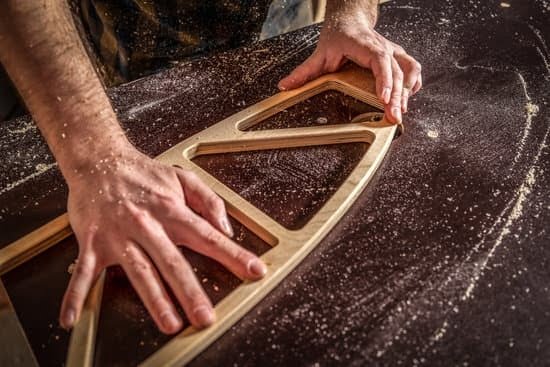Woodwork is a craft that relies heavily on the use of joints to create strong, durable, and visually appealing pieces. But why are joints necessary in woodwork? Joints play a crucial role in ensuring the structural integrity of woodworking projects by connecting different pieces of wood together seamlessly. Without joints, woodwork projects would lack stability and longevity, making them prone to breakage and damage.
In the world of woodworking, joints refer to the method used to join two or more pieces of wood together. The type of joint chosen can significantly impact not only the overall strength and durability of the project but also its aesthetics. From simple butt joints to intricate dovetail joints and traditional mortise and tenon joints, there are a variety of options available for woodworkers to choose from based on their specific needs and desired outcomes.
Understanding the importance of joints in woodwork goes beyond just creating functional pieces. Joints can also enhance the beauty and design of a project, elevating it from a mere construction to a work of art. By exploring different types of joints, mastering proper techniques, and avoiding common mistakes, woodworkers can achieve professional-level results that stand the test of time.
Importance of Joints in Structural Integrity of Woodwork Projects
Joints play a crucial role in ensuring the structural integrity of woodwork projects. Without proper joints, the individual pieces of wood would not be able to support each other effectively, leading to instability and potential failure of the entire piece. This is why it is essential for woodworkers to understand the different types of joints available and how they can be used to create strong and durable connections between wood pieces.
Enhancing Strength and Stability
One of the main reasons why joints are necessary in woodwork is that they help distribute forces evenly across the various components of a project. By creating secure connections between pieces of wood, joints prevent them from shifting or separating under stress, ultimately increasing the overall strength and stability of the structure. This is particularly important in furniture making, where durability and longevity are key considerations.
Preventing Warping and Movement
In addition to enhancing strength, well-crafted joints can also help minimize warping and movement in woodwork projects. When wood absorbs moisture or experiences changes in temperature, it has a tendency to expand, contract, or warp. By using appropriate joints that accommodate these natural movements, such as dovetail or mortise and tenon joints, woodworkers can prevent issues like gaps forming between pieces or unsightly warping over time.
Different Types of Joints Used in Woodwork (Eg Butt Joint, Dovetail Joint, Mortise and Tenon Joint)
Joints are an essential component in woodworking, playing a crucial role in the overall structure and integrity of woodwork projects. They allow pieces of wood to be connected together firmly, creating a strong bond that ensures the longevity and durability of the final piece. Without joints, woodwork projects would lack stability and could easily fall apart under pressure or over time. That is why joints are necessary in woodwork to provide strength and support to various structures.
There are several different types of joints used in woodworking, each with its unique characteristics and advantages. One common type is the butt joint, which involves joining two pieces of wood at their ends by simply butting them together. While this joint is quick and easy to create, it may not be the strongest option for load-bearing applications due to its limited glue surface.
On the other hand, dovetail joints are known for their exceptional strength and resistance to pulling forces. These joints feature interlocking pins and tails that create a secure connection between two pieces of wood without the need for additional fasteners. Dovetail joints are commonly used in high-quality furniture making where durability is paramount.
Another popular type of joint is the mortise and tenon joint, which consists of a projecting tongue (tenon) on one piece of wood that fits into a cavity (mortise) on another piece. This type of joint provides excellent strength and stability, making it suitable for heavy-duty woodworking projects such as tables, chairs, and doors. The precise fit between the tenon and mortise ensures a snug connection that can withstand significant weight loads.
| Types of Joints | Main Characteristics |
|---|---|
| Butt Joint | Quick but may lack strength |
| Dovetail Joint | Exceptionally strong and resistant to pulling forces |
| Mortise and Tenon Joint | Provides excellent strength and stability |
How Joints Impact the Overall Aesthetics of a Woodwork Project
Joints play a crucial role not only in the structural integrity of woodwork projects but also in the overall aesthetics of the finished piece. The choice of joint can greatly impact the visual appeal and design of the project, making it essential for woodworkers to carefully consider which type of joint to use based on their desired look and functionality.
Choice of Joint Design
The design of the joint itself can add an element of beauty and sophistication to a woodwork project. For example, intricate joints like dovetail or finger joints can create visually appealing patterns and details that enhance the overall aesthetic appeal of furniture or other woodworking creations. On the other hand, simpler joints like butt joints may offer a clean and minimalist look that complements modern or minimalist designs.
Integration With Overall Design
In addition to the actual design of the joint, how it integrates with the overall design of the piece is also crucial for aesthetics. A well-executed joint that seamlessly blends into the structure can elevate the craftsmanship and quality of the project.
On the contrary, poorly executed or mismatched joints can detract from the beauty of the woodwork and make it appear amateurish or unfinished. Woodworkers must carefully plan and execute their joints to ensure they enhance, rather than detract from, the visual appeal of their creations.
Finish and Detailing
The way joints are finished and detailed can also contribute significantly to the overall aesthetics of a woodwork project. Whether joints are left exposed as a design feature or concealed for a seamless look, paying attention to details such as grain alignment, color matching, and finishing techniques is essential for creating a visually stunning piece.
Properly executed joints that are meticulously crafted and finished can elevate a simple woodworking project into a work of art that showcases both skillful technique and aesthetic sensibility.
Common Mistakes to Avoid When Creating Joints in Woodwork
When working on woodwork projects, understanding the importance of joints is crucial for ensuring structural integrity and aesthetic appeal. Joints in woodworking are essential as they help connect different pieces of wood together, providing strength and stability to the overall piece.
Without properly constructed joints, woodwork projects would be prone to falling apart or becoming weak over time. This is why taking the time to learn about the different types of joints and how to create them correctly is paramount for any woodworker.
To avoid common mistakes when creating joints in woodwork, it is important to pay attention to detail and precision. Here are some key mistakes to steer clear of:
- Not properly measuring and marking where the joint will be created can lead to misalignment and a poor fit.
- Rushing through the cutting and shaping process without ensuring accurate angles and dimensions can result in weak joints that are prone to failure.
- Using inadequate tools or techniques for creating joints can compromise the strength and durability of the joint, impacting the overall quality of the woodwork project.
By being mindful of these mistakes and taking the necessary steps to avoid them, woodworkers can elevate their craftmanship and produce high-quality pieces that stand the test of time. Remember, investing time in mastering joint techniques will ultimately lead to more successful and visually appealing woodworking projects.
Tools and Techniques for Creating Strong and Durable Joints
In woodworking, joints play a crucial role in ensuring the strength and durability of a project. Properly crafted joints not only enhance the structural integrity of the piece but also contribute to its overall aesthetic appeal. There are various tools and techniques that woodworkers can utilize to create strong and durable joints that will stand the test of time.
One essential tool for creating joints in woodworking is a quality chisel. A sharp chisel allows for precise cuts and clean finishes when working on joints like dovetail or mortise and tenon. Additionally, a mallet can be handy for driving chisels and ensuring a snug fit of the joint components. Another indispensable tool is a combination square, which helps in accurately measuring and marking out the joinery before making any cuts.
When it comes to techniques for creating strong joints, precision is key. Careful measuring, marking, and cutting are essential steps to ensure that the joint fits together seamlessly.
It’s also crucial to pay attention to details such as grain direction when cutting the joint components to prevent tear-out and achieve a tight bond between the pieces. Utilizing clamps during glue-up is another technique that can help maintain alignment and pressure while the adhesive cures, resulting in a sturdy joint.
Advantages and Disadvantages of Using Various Types of Joints in Woodwork
Joints are a crucial aspect of any woodworking project as they play a vital role in the structural integrity and overall strength of the piece. Without proper joints, woodwork projects would be prone to splitting, warping, and collapsing under stress. This is why joints are necessary in woodwork – they provide the necessary reinforcement to ensure that a piece can withstand the test of time.
There are various types of joints used in woodworking, each with its own advantages and disadvantages. For example, a butt joint is quick and easy to create but may not be as strong as other types of joints.
On the other hand, a dovetail joint provides exceptional strength due to its interlocking design but can be more challenging to make. Understanding the pros and cons of different joint options allows woodworkers to choose the most suitable one for their specific project requirements.
In addition to structural considerations, joints also significantly impact the aesthetics of a woodwork piece. Well-crafted joints seamlessly blend into the overall design, while poorly executed joints can detract from the beauty of the finished product. Woodworkers must carefully select and execute their joints to ensure that they not only provide functional support but also enhance the visual appeal of their creations.
Case Studies/Examples of Famous Woodwork Projects That Showcase the Importance of Joints
As woodworking enthusiasts delve deeper into the craft, they begin to understand the critical role that joints play in the overall structure and durability of their projects. One famous example that highlights the importance of joints is the intricate work found in traditional Japanese wood joinery.
The art of Japanese joinery, known as “kigumi,” showcases masterful techniques that rely on precise cuts and assembly to create complex structures without the need for nails or screws. This ancient practice demonstrates how joints not only provide strength but also contribute to the elegant beauty of a finished piece.
Another notable case study is the iconic Windsor chair design, which relies heavily on joints such as mortise and tenon connections to ensure its stability and longevity. The use of these specific joints allows for a seamless integration of various components, resulting in a chair that is not only visually striking but also robust enough to withstand years of use.
By studying classic examples like the Windsor chair, woodworkers can gain valuable insights into how different types of joints can enhance both the form and function of their creations.
Furthermore, modern architectural marvels such as timber-framed buildings showcase how strategic joint design can support expansive structures while maintaining a sense of elegance and simplicity. The use of exposed post-and-beam joints not only adds character to these buildings but also serves a practical purpose by distributing weight evenly and providing structural support.
These examples underscore why joints are necessary in woodwork, as they not only hold pieces together but also contribute to the overall aesthetics and functionality of a project.
Conclusion
In conclusion, the importance of joints in woodwork cannot be overstated. These crucial elements not only provide structural integrity to woodworking projects but also play a significant role in enhancing the overall aesthetics. Joints act as the connecting points that hold different pieces of wood together, ensuring durability and stability in the final piece.
One of the primary reasons why joints are necessary in woodwork is their impact on the strength and longevity of a project. By carefully selecting and creating the right type of joint for a specific woodworking task, craftsmen can ensure that their creations stand the test of time. Whether it’s a simple butt joint or a complex dovetail joint, each type serves a unique purpose in reinforcing connections and preventing potential weaknesses.
Furthermore, understanding how different types of joints work and when to use them can make all the difference in the success of a woodworking project. By learning from common mistakes and taking advantage of the appropriate tools and techniques, woodworkers can elevate their craft to new heights. Ultimately, mastering the art of creating strong and durable joints is essential for anyone looking to excel in woodworking and produce high-quality pieces that will be admired for years to come.
Frequently Asked Questions
Why Are Joints Important in Woodworking?
Joints are crucial in woodworking because they allow pieces of wood to be connected together to create a larger structure or project. They provide strength, stability, and flexibility in design, enabling different parts to come together seamlessly.
What Are the Advantages of Finger Joints in Woodwork?
Finger joints offer several advantages in woodwork, primarily due to their increased surface area for glue application. This results in a stronger bond between the pieces of wood, making the joint more durable and able to withstand greater amounts of pressure or weight.
How Does the Joint Contribute to the Overall Strength and Stability of the Woodwork?
The joint plays a significant role in determining the overall strength and stability of the woodwork by distributing forces evenly across the connected pieces. A well-constructed joint can prevent sagging, warping, or breaking of the structure over time, ensuring its longevity and structural integrity.
Additionally, joints add rigidity and support to the overall design, enhancing its ability to withstand external forces or weight loads.

Hi everyone! I’m a woodworker and blogger, and this is my woodworking blog. In my blog, I share tips and tricks for woodworkers of all skill levels, as well as project ideas that you can try yourself.





